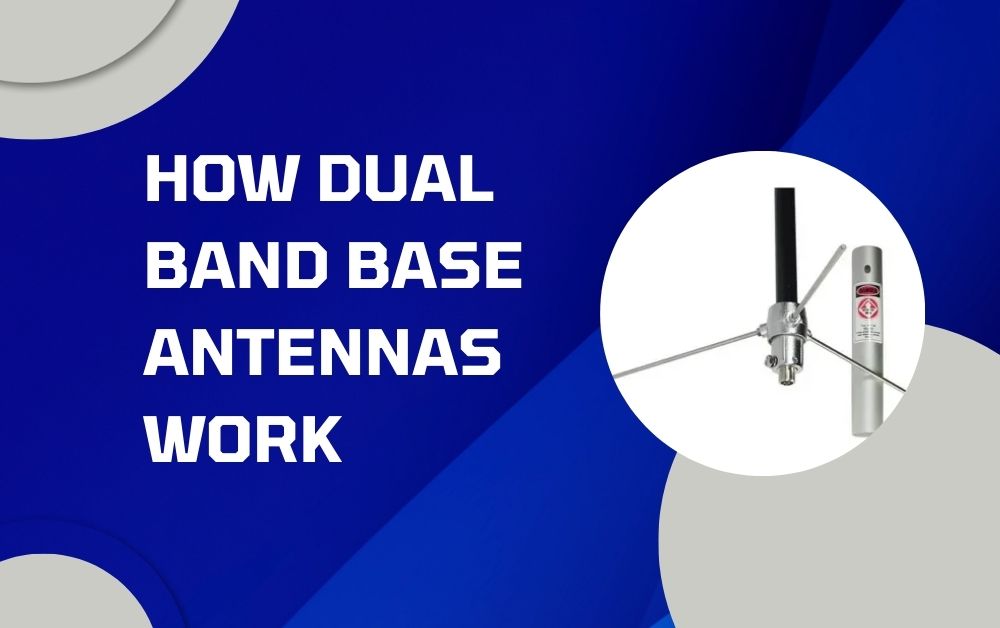
Dual band base antennas are essential components in modern communication systems. They are widely used by amateur radio enthusiasts, emergency services, and other communication professionals. This blog will explain how dual band base antennas work, breaking down the technical aspects into simple, easy-to-understand language.
What is a Dual Band Base Antenna?
A dual band base antenna is a type of antenna that can operate on two different frequency bands. This means it can send and receive signals on two separate frequency ranges. For example, a common dual band base antenna might operate on both the VHF (Very High Frequency) and UHF (Ultra High Frequency) bands. These antennas are popular because they offer flexibility and improved performance compared to single band antennas. By being able to switch between two frequency bands, they can provide better coverage and more reliable communication.
Dual band base antennas are used in various applications, including amateur radio, public safety, and commercial communication systems. They are often installed on rooftops, towers, or other high structures to maximize their range and effectiveness. The ability to use multiple frequency bands makes these antennas highly versatile and suitable for different communication needs. Whether you are a radio hobbyist or a professional in the field, understanding how dual band base antennas work can help you get the most out of your communication equipment.
Note – Ready to enhance your communication setup with top-quality Dual band base antennas? Visit SoyuzTech today and explore our wide range of high-performance antennas. Get reliable, versatile solutions tailored to your needs. Don’t wait—upgrade your system with SoyuzTech now!
How Does a Dual Band Base Antenna Operate?
The operation of a dual band base antenna is based on the principle of resonance. Resonance occurs when an antenna’s length is a specific fraction of the wavelength of the signal it is intended to transmit or receive. This matching of the antenna length to the signal wavelength allows for efficient transmission and reception of radio waves. In a dual band base antenna, this principle is applied to two different frequency bands, enabling the antenna to operate efficiently on both bands.
A dual band base antenna typically has elements, or sections, that are designed to resonate at the two different frequency bands. These elements are carefully tuned to ensure that the antenna can switch between the frequency bands as needed. This tuning process involves adjusting the length and position of the elements to match the wavelengths of the desired frequencies. When a signal is transmitted, the antenna radiates the electromagnetic waves into the surrounding space. When a signal is received, the antenna captures the electromagnetic waves and converts them back into electrical signals.
The ability to operate on two frequency bands allows dual band base antennas to provide more reliable communication. In situations where one frequency band may be congested or experiencing interference, the antenna can switch to the other band to maintain clear communication. This flexibility is particularly valuable in emergency situations where reliable communication is critical. By understanding how dual band base antennas operate, users can make informed decisions about their communication equipment and ensure they are getting the best performance possible.
The Design of Dual Band Base Antennas
The design of dual band base antennas involves several key components that work together to achieve efficient operation on two different frequency bands. One of the main components is the radiator, which is the part of the antenna that emits or receives electromagnetic waves. In a dual band base antenna, the radiator is often designed with multiple sections, each tuned to a specific frequency band. These sections are carefully arranged to ensure that they do not interfere with each other while operating on their respective bands.
Another important component of a dual band base antenna is the matching network. The matching network is responsible for ensuring that the antenna is properly tuned to the desired frequency bands. It helps to match the impedance of the antenna to the impedance of the transmitter or receiver, which is crucial for efficient transmission and reception of signals. The matching network can be adjusted to fine-tune the antenna’s performance on each frequency band. This adjustment process involves changing the length and position of the antenna elements to achieve the best possible match.
The materials used in the construction of dual band base antennas also play a significant role in their performance. High-quality materials, such as copper and aluminum, are commonly used because they have excellent electrical conductivity. These materials help to minimize signal loss and ensure that the antenna operates efficiently. Additionally, the design of the antenna’s housing or casing can affect its performance. The housing should be weather-resistant and durable to protect the antenna from environmental factors that could degrade its performance.
The design of dual band base antennas is a complex process that requires careful consideration of various factors. By understanding the design principles and components involved, users can better appreciate the capabilities of these antennas and make informed decisions about their communication equipment. Whether you are installing a dual band base antenna for amateur radio or professional use, paying attention to the design and construction can help you achieve the best possible performance.
Benefits of Using Dual Band Base Antennas
There are several benefits to using dual band base antennas, making them a popular choice for many communication applications. One of the primary benefits is their ability to provide reliable communication on two different frequency bands. This flexibility allows users to switch between frequency bands as needed, ensuring clear and uninterrupted communication. In situations where one frequency band may be experiencing interference or congestion, the ability to switch to an alternative band can be invaluable.
Another significant benefit of dual band base antennas is their improved range and coverage. By operating on two different frequency bands, these antennas can provide better signal propagation and reach areas that may be difficult to cover with a single band antenna. This improved range is particularly important in emergency communication situations where reliable coverage is critical. Dual band base antennas are often used by public safety agencies, emergency services, and other organizations that require dependable communication in challenging environments.
Dual band base antennas also offer cost savings compared to using separate antennas for each frequency band. By combining the functionality of two antennas into a single unit, users can reduce the overall cost and complexity of their communication systems. This cost savings can be especially beneficial for organizations with limited budgets or those looking to streamline their communication infrastructure. Additionally, the reduced complexity of using a single antenna for dual band operation can simplify installation and maintenance, making it easier for users to manage their communication systems.
The versatility and performance of dual band base antennas make them an excellent choice for a wide range of communication applications. Whether you are an amateur radio enthusiast, a professional communicator, or part of an emergency response team, using a dual band base antenna can provide numerous benefits. Understanding these benefits can help you make informed decisions about your communication equipment and ensure that you are getting the best possible performance from your antenna.
Conclusion
Dual band base antennas are an essential component in modern communication systems, offering flexibility, improved performance, and cost savings. By understanding how these antennas work, users can appreciate their capabilities and make informed decisions about their communication equipment. Whether you are installing a dual band base antenna for amateur radio, public safety, or commercial use, paying attention to the design and operation of the antenna can help you achieve the best possible performance.
These antennas operate on the principle of resonance, with carefully tuned elements that allow them to switch between two frequency bands. The design and construction of dual band base antennas involve several key components, including the radiator, matching network, and high-quality materials. The benefits of using dual band base antennas include reliable communication, improved range and coverage, and cost savings compared to using separate antennas for each frequency band.
For more insightful articles related to this topic, feel free to visit guestpostreview.com






